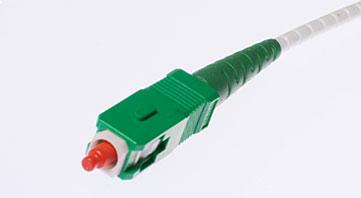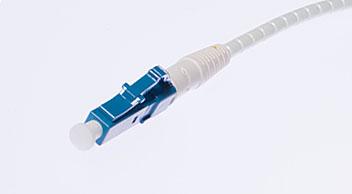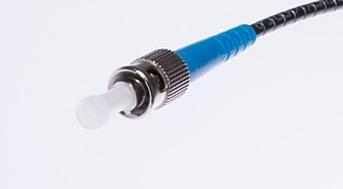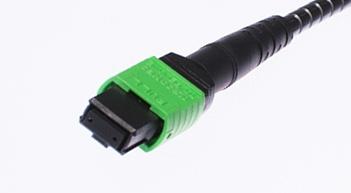- Related articles
- All Cisco GLC-FE-100LX-RGD’s Information (Overview, Features, Datasheet PDF, Price, Specif
- Optical Transceivers for Cisco SG350XG-24F-K9-UK Switch
- Installation of Fiber Optic Cable
- All Cisco QSFP-40G-CSR4's information (List price, Specs, Datasheet PDF, Compatibility mat
- Cost Effective Compatible Cisco Transceivers
- Optical Transceivers for Cisco SF250-48HP-K9-EU Switch
- How to Configure the Dual Ethernet Adapter?
- All Cisco ONS-SI-155-I1's information (List price, Specs, Datasheet PDF, Compatibility mat
- Cisco 10GBASE SFP+ Modules Overview
- Optical Transceivers for Cisco WS-C3750V248PSE-RF Switch

Introduction
The fiber optic cable connectors are used to terminate the fibers and contain up to 12 strands. As at today, the ST is considered as the best and most popular connector in entire multimode networks and widely adopted by many campuses and buildings. Some connectors are plastic while others are metal.
Fiber Optic Cable Connectors
Fiber optic cable connectors are hardware installed on fiber cable ends to provide cable attachment to a transmitter, receiver or other cables. In order for information to be transmitted efficiently, the fiber cores must be properly aligned. They are usually devices that can be connected and disconnected repeatedly.
There are many types of fiber optic cable connectors:
ST Connectors: Slotted bayonet type connector with the long ferrule. Common connector for multimode fibers.
FC Connectors: Screw on type connector. Popular with single mode fibers.
SC Connectors: Push/pull connector that can also be used with duplex fiber construction.
LC Connectors: Much like the ST connector but with a ferrule that is half the size.
MT-RJ Connectors: Connector configured for duplex fibers with both fibers in one ferrule.
MU Connectors: Much like the SC connector but with a ferrule about half the size.
1. SC Connector
The SC was developed by the laboratories at Nippon Telegraph and Telephone (NTT) in the mid-eighties and was one of the first connectors to hit the market following the advent of ceramic ferrules. Sometimes referred to as the ‘square connector’ the SC has a push-pull coupling end face with a spring loaded ceramic ferrule. Initially intended for Gigabit Ethernet networking, it was standardized into the telecommunications specification TIA-568-A in 1991 and slowly grew in popularity as manufacturing costs came down. Due to its excellent performance, it dominated fiber optics for over a decade with only the ST rivaling it. Thirty years on, it remains the second most common connector for polarization maintaining applications. The SC is ideally suited for datacoms and telecoms applications including point to point and passive optical networking.

2. LC Connector
Considered by some to be the modern replacement of the SC connector; its introduction was less successful, in part due to initially high license fees from inventor Lucent Corporation. Also a push-pull connector, the LC utilizes a latch as opposed to the SC locking tab and with a smaller ferrule, it is known as a small form factor connector. Having half the footprint of the SC connector gives it huge popularity in datacoms and other high-density patch applications, as its combination of small size and latch feature make it ideal for densely populated racks/panels. With the introduction of LC compatible transceivers and active networking components, its steady growth in the FTTH arena is likely to continue.

3. FC Connector
The FC was the first optical fiber connector to use a ceramic ferrule, but unlike the plastic bodied SC and LC, it utilizes around screw-type fitment made from nickel-plated or stainless steel. The connector end face relies on an alignment key for correct insertion and is then tightened into the adapter/jack using a threaded collet. Despite the additional complexity both in manufacturing and installation, it’s still the connector of choice for precise measuring equipment such as OTDRs.
Initially intended for datacoms and telecoms applications, its use has reduced since the introduction of the SC and LC. These deliver similar performance to the FC but both have less expensive components and are quicker to connect. However, the screw-on collet of the FC does make it particularly effective in high vibration environments, ensuring that the spring-loaded ferrule is firmly mated.

4. ST Connector
The ST connect was developed by AT&T shortly after the arrival of the FC. At a glance, they can be mistaken for one another but the ST uses a bayonet fitment rather than a screw thread. Usage has declined in recent decades, for the same reasons as the FC. Additionally, it cannot be terminated with an angled polish, which limits use in single mode fiber and FTTH applications.
Deployed predominately in multi-mode datacoms it is most common in network environments such as campuses, corporate networks and in military applications where the quick connecting bayonet had its advantages at the time. It is typically installed into infrastructures that were built at the turn of the century; when retro-fitting, STs are typically swapped out for more cost effective SC and LC connectors.

5. MTP/MPO connector
The MT ferrule connector is another of NTT’s inventions and has been around since the 1980s, although the technology has only recently become popular under branded versions of the Multiple Fiber Push-On/Pull-Off connector, such as MTP and MPO. It is larger than the other connectors but for good reason - it can support up to 24 fibers in a single ferrule.
Multi-fiber connectors are not currently designed for field-fit applications so must be lab terminated. In high-density patch environments such as data centers, they are used extensively, both in single mode and multi-mode wavelengths. On a ‘per-fiber’ basis the costs are relatively inexpensive.

Conclusion
There are different types of Fiber Optic Cable Connectors that you can make your choice from. It is very important to choose the most suitable Fiber Optic Cable Connectors regarding your purpose.





































































